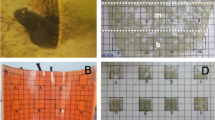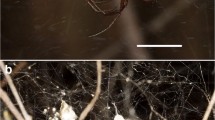Summary
We conducted daily censuses on a marked population of the damselflyCalopteryx maculata for two complete breeding seasons to document the reproductive tactics of individual males. Overall, 78% of the 600 males studied defended territories and 14% of those territorial males were also observed engaged in sneaking behaviour on some days. When sneaking, males did not defend territories but attempted to steal females from other males' territories. Sneakers were usually previously successful territorial males who emerged early in the season and began sneaking relatively late in their lives (Fig. 2). Thus the adoption of sneaking was conditional and related to both male age and population density. We suggest that sneaking, in this species, is a “make the best of a bad situation” tactic adopted when intense male-male competition forced older males to abandon territoriality. Thus, sneaking allowed males with declining resource holding potential to prolong their reproductive careers after they were no longer able to hold a territory.
Similar content being viewed by others
References
Alcock J (1979) Multiple mating inCalopteryx maculata (Odonata: Calopterygidae) and the advantage of non-contact guarding by males. J Nat Hist 13:439–446
Alcock J (1983) Mate guarding and the acquisition of new mates inCalopteryx maculata (P. De Beauvois) (Zygoptera: Calopterygidae). Odonatologica 12:153–159
Arak A (1984) Sneaky breeders. In: CJ Barnard (ed) Producers and scavengers. Croom Helm, London, pp 154–194
Austad SN (1984) A classification of alternative reproduction behaviours and methods for field-testing ESS Models. Am Zool 24:309–319
Banks MJ, Thompson DJ (1986) Lifetime mating success in the damselflyCoenagrion puella. Anim Behav 33:1175–1183
Begon M, Harper JL, Townsend CR (1986) Ecology: Individuals, Populations, and Communities. Sinauer, Sunderland, Massachusetts
Cade W (1980) Alternative male reproductive behaviours. Fla Entomol 63:30–45
Campanella PJ, Wolf LL (1974) Temporal leks as a mating system in a temperate zone dragonfly (Odonata: Anisoptera). I.Plathemis lydia (Drury). Behaviour 51:49–87
Caro TM, Bateson P (1986) Organization and ontogeny of alternative tactics. Anim Behav 34:1483–1499
Dawkins R (1980) Good strategy or evolutionarily stable strategy? In: Barlow GW, Silverberg J (eds) Sociobiology: beyond nature/nurture? Westview Press, Boulder, Colorado, pp 331–367
Dominey WJ (1984) Alternative mating tactics and evolutionarily stable strategies. Am Zool 24:385–396
Fincke OM (1982) Lifetime mating success in a natural population of the damselfly,Enallagma hageni (Walsh) (Odonata: Coenagrionidae). Behav Ecol Sociobiol 10:293–303
Fincke OM (1984) Sperm competition in the damseflyEnallagma hageni (Walsh) (Odonata: Coenagrionidae): benefits of multiple mating to males and females. Behav Ecol Sociobiol 14:235–240
Fincke OM (1985) Alternative mate-finding tactics in a nonterritorial damselfly (Odonata: Coenagrionidae). Anim Behav 33:1124–1137
Fried CS, May ML (1983) Energy expenditure and food intake of territorial malePachydiplax longipennis (Odonata: Libellulidae). Ecol Entomol 8:283–293
Gross M (1982) Sneakers, satellites and parentals: polymorphic mating strategies in North American sunfishes. Z Tierpsychol 60:1–26
Gross M (1985) Disruptive selection for alternative life histories in salmon. Nature (Lond) 313:47–48
Hogan-Warburg AJ (1966) Social Behaviour of the ruff,Philomachus pugnax (L). Ardea 54:109–229
Howard RD (1978) The evolution of mating strategies in bullfrogs,Rana catesbeiana. Evolution 32:850–871
Johnson C (1962) Breeding behaviour and oviposition inCalopteryx maculatum (Beauvois) (Odonata: Calopterygidae). Am Midl Nat 68:242–247
Koenig WD, Albano SS (1985) Patterns of territoriality and mating success in the White-tailed SkimmerPlathemis lydia (Odonata: Anisoptera). Am Midl Nat 114:1–12
Miller PL (1983) The duration of copulation correlates with other aspects of mating behaviour inOrthetrum chysostigmata (Burmeister) (Anisoptera: Libellulidae). Odonatologica 12:227–238
Parr MJ (1980) Territorial behaviour of the African libellulidOrthetrum julia Kirby (Anisoptera). Odonatologica 9:75–99
Parr MJ (1983) An analysis of territoriality in libellulid dragonflies (Anisoptera: Libellulidae). Odonatologica 12:39–57
Rubenstein DI (1980) On the evolution of alternative mating strategies. In: JER Staddon (ed) Limits to action: the allocation of individual behaviour. Academic Press, New York, pp 65–100
Tsubaki Y, Ono T (1986) competition for territorial sites and alternative mating tactics in the dragonfly,Nannophya pygmaea Rambur (Odonata: Libellulidae). Behaviour 97:234–251
Utzeri C, Falchetti E, Carchini G (1983) The reproductive behaviour inCoenagrion lindeni (Selys) in Central italy (Zygoptera: Coenagrionidae). Odonatologica 12:259–278
Waage JK (1972) Longevity and mobility of adultCalopteryx maculata (Beauvois, 1805) (Zygoptera: Calopterygidae). Odonatologica 1:155–162
Waage JK (1973) Reproductive behaviour and its relation to territoriality inCalopteryx maculata (Beauvois) (Odonata: Calopterygidae). Behaviour 487:240–256
Waage JK (1978) Oviposition duration and egg deposition rates inCalopteryx maculata (Beauvois) (Zygoptera: Calopterygidae). Odontalogica 7:77–88
Waage JK (1979a) Adaptive significance of postcopulatory guarding of mates and nonmates by maleCalopteryx maculata (Odonata). Behav Ecol Sociobiol 6:147–154
Waage JK (1979b) Dual function of the damselfly penis: Sperm removal and transfer. Science 203:916–918
Waage JK (1986) Evidence for widespread sperm displacement ability among Zygoptera (Odonata) and the means for predicting its presence. Biol J Linnaean Soc 28:285–300
Waltz EC, Wolf LL (1984) By Jove! Why do alternative mating tactics assume so many different forms? Am Zool 24:333–343
Author information
Authors and Affiliations
Rights and permissions
About this article
Cite this article
Forsyth, A., Montgomerie, R.D. Alternative reproductive tactics in the territorial damselflyCalopteryx maculata: sneaking by older males. Behav Ecol Sociobiol 21, 73–81 (1987). https://doi.org/10.1007/BF02395434
Received:
Accepted:
Issue Date:
DOI: https://doi.org/10.1007/BF02395434




